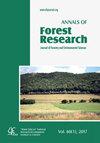Economic efficiency of fully mechanized timber harvesting in coniferous stands of the 2nd age class
IF 2.9
3区 农林科学
Q2 FORESTRY
引用次数: 0
Abstract
The aim of the study was to determine the unit costs of mechanized timber harvesting in pine stands where early thinning was being performed, and to determine the relationship between the cost level and the volume of harvested trees, the harvester model and field conditions. Analysis focused on timber harvesting with the use of small- and mid-sized harvesters. The tested harvesters were specialized forestry machines (Vimek, Sampo, Profi-Pro, Ponsse) and a construction machine (Fao-Far). Terrain accessibility variants were distinguished in relation to furrows between which trees had been planted in the past: flat terrain with the depth of unevenness up to 20 cm, up to 40 cm, and over 40 cm. The operating costs of the analyzed harvesters varied significantly, an hour of operation of the machine that was the cheapest to use (Fao-Far) cost nearly 2.5 times less (37.3 €) than the Profi-Pro harvester, which was the most expensive in operation (89.1 €). In stands without furrows, the lowest unit costs were noted for the Sampo harvester: 8.4 €·m-3. The other small harvesters, Vimek and Fao-Far, were slightly more expensive to use: 10.3 €·m-3 and 9.1 €·m-3, respectively. In areas where furrows were up to 20 cm deep, the cheapest solution was timber harvesting with the Fao-Far harvester (9.9 €·m-3). In areas where furrows were up to 40 cm deep, timber harvesting was the cheapest with the Sampo harvester (10.7 €·m-3), while harvesters Vimek and Fao-Far were characterized by a similar cost intensity, amounting to just over 12 €·m-3. In stands with furrows deeper than 40 cm, it was cheapest to use the Ponsse harvester (10.4 €·m-3). The cost of operation of the Profi-Pro harvester was higher by approx. 25% (14.0 €·m-3). With the current level of the financing of mechanized timber harvesting in Poland (about 11 €·m-3), small harvesters Vimek, Sampo and Fao-Far are cost-effective when single tree volume exceeds 0.05-0.06 m3. Medium harvesters, Profi-Pro and Ponsse, are cost-effective when unit volumes of harvested trees reach 0.08 and 0.11 m3 respectively. The cost-effectiveness of the tested harvesters increased when working shifts were extended.2龄针叶林木材机械化采伐的经济效益
这项研究的目的是确定在进行早期间伐的松林中机械化采伐木材的单位成本,并确定成本水平与采伐树木的数量、采伐模式和田间条件之间的关系。分析的重点是使用中小型采伐机采伐木材。测试的收割机是专门的林业机械(Vimek、Sampo、Profi-Pro、Ponsse)和工程机械(Fao-Far)。地形可达性变化与过去种植树木的犁沟有关:平坦地形,不平整深度达20 cm,高达40 cm和超过40 cm。所分析的收割机的运行成本差异很大,最便宜的收割机(Fao-Far)每小时的运行成本比最昂贵的Profi-Pro收割机(89.1欧元)低近2.5倍(37.3欧元)。在没有犁沟的林分中,Sampo收割机的单位成本最低,为8.4欧元·m-3。其他小型收割机Vimek和Fao-Far的使用成本略高:分别为10.3欧元·m-3和9.1欧元·m-3。在犁沟深达20厘米的地区,最便宜的解决方案是使用Fao-Far收割机采伐木材(9.9欧元·m-3)。在犁沟深达40厘米的地区,Sampo收割机的木材采伐成本最低(10.7欧元·m-3),而Vimek和Fao-Far收割机的成本强度相似,仅略高于12欧元·m-3。在沟深超过40厘米的林分中,使用Ponsse收割机是最便宜的(10.4欧元·m-3)。Profi-Pro收割机的操作成本大约要高。25%(14.0€·m-3)。以波兰目前机械化木材采伐的资金水平(约11欧元·m-3),当单棵树的体积超过0.05-0.06立方米时,小型采伐机Vimek、Sampo和Fao-Far具有成本效益。中型收割机Profi-Pro和Ponsse在采伐树木的单位体积分别达到0.08和0.11 m3时具有成本效益。当工作班次延长时,测试收割机的成本效益增加。
本文章由计算机程序翻译,如有差异,请以英文原文为准。
求助全文
约1分钟内获得全文
求助全文
来源期刊

Annals of Forest Research
FORESTRY-
CiteScore
2.20
自引率
11.10%
发文量
11
审稿时长
12 weeks
期刊介绍:
Annals of Forest Research is a semestrial open access journal, which publishes research articles, research notes and critical review papers, exclusively in English, on topics dealing with forestry and environmental sciences. The journal promotes high scientific level articles, by following international editorial conventions and by applying a peer-review selection process.
 求助内容:
求助内容: 应助结果提醒方式:
应助结果提醒方式:


